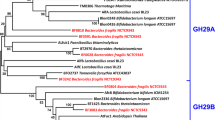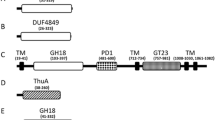Abstract
Bacteroides fragilis is a clinically important anaerobic pathogen present in the human gastrointestinal tract and is involved in a high number of anaerobic peritoneal infections. The complete genome sequence of B. fragilis NCTC 9343 revealed the presence of several putative fucosyltransferase gene homologues known as alpha-1,3-fucosyltransferases (α-1,3-FucTs). However, their expression and functional activities have not been studied. Here, we report the molecular cloning, functional expression, and characterization of the alpha-1,3-fucosyltransferase 3 (α-1,3-FucT3) enzyme from B. fragilis NCTC 9343. The polymerase chain reaction (PCR)-based approach was used to clone the 331 amino acid long (MW, ∼39 kDa) PCR product encoding fucosyltransferase enzyme. The enzyme had low identity of 30–40% with other known α-1,3-FucTs from Azospirillum sp, Rickettsia bellii, and different strains of Helicobacter pylori. An in vitro enzyme reaction analysis showed the ability of the enzyme to transfer the fucose moiety from guanosine-5′-diphosphate β-l-fucose to the N-acetyllactosamine to produce Lewis X. The reaction product, Lewis X was confirmed by thin layer chromatography, liquid chromatography-mass spectroscopy, and 1H-nuclear magnetic resonance analyses.
Similar content being viewed by others
References
Lowe, J. B. (2003) Glycan-dependent leukocyte adhesion and recruitment in inflammation. Curr. Opin. Cell Biol. 15: 531–538.
Nakamori, S., M. Kameyama, S. Imaoka, H. Furukawa, O. Ishikawa, Y. Sasaki, T. Kabuto, T. Iwanaga, Y. Matsushita, and T. Irimura (1993) Increased expression of sialyl Lewis X antigen correlates with poor survival in patients with colorectal carcinoma: Clinicopathological and immunohistochemical study. Cancer Res. 53: 3632–3637.
Nguyen, M., N. A. Strubel, and J. Bischoff (1993) A role for sialyl Lewis-X/A glycoconjugates in capillary morphogenesis. Nature 365: 267–269.
Artavanis-Tsakonas, S., M. D. Rand, and R. J. Lake (1999) Notch signaling: cell fate control and signal integration in development. Sci. 284: 770–776.
Ilver, D., A. Arnqvist, J. Ögren, I. -M. Frick, D. Kersulyte, E. T. Incecik, D. E. Berg, A. Covacci, L. Engstrand, and T. Borén (1998) Helicobacter pylori adhesin binding fucosylatedhistoblood group antigens revealed by retagging. Sci. 279: 373–377.
Appelmelk, B. J., I. Simoons-Smit, R. Negrini, A. P. Moran, G. O. Aspinall, J. G. Forte, T. De Vries, H. Quan, T. Verboom, J. J. Maaskant, P. Ghiara, E. J. Kuipers, E. Bloemena, T. M. Tadema, R. R. Townsend, K. Tyagarajan, J. M. Jr. Crothers, M. A. Monteiro, A. Savio, and J. De Graaff (1996) Potential role of molecular mimicry between Helicobacter pylori Lipopolysaccharide and host lewis blood group antigens in autoimmunity. Infect. Immun. 64: 2031–2040.
Ma, B., J. L. Simala-Grant, and E. D. Taylor (2006) Fucosylation in prokaryotes and eukaryotes. Glycobiol. 16:158–184.
Cantarel, B. L., P. M. Coutinho, C. Rancurel, T. Bernard, V. Lombard, and B. Henrissat (2009) The Carbohydrate-active enzymes database (CAZy): An expert resource for glycogenomics. Nucleic Acids Res. 37: 233–238.
Paulson, J. C. and K. J. Colley (1989) Glycosyltransferases structure, localization, and control of cell type-specific glycosylation. J. Biol. Chem. 264: 17615–17618.
Rabbani, S., V. Miksa, B. Wipf, and B. Ernst (2005) Molecular cloning and functional expression of a novel Helicobacter pylori α-1,4fucosyltransferase. Glycob. 15: 1076–1083.
Monteiro, M. A., K. H. Chan, D. A. Rasko, D. E. Taylor, P. Y. Zheng, B. J. Appelmelk, H. P. Wirth, M. Yang, M. J. Blaser, S. O. Hynes, A. P. Moran, and M. B. Perry (1998) Simultaneous expression of type 1 and type 2 Lewis blood group antigens by Helicobacter pylori lipopolysaccharides. Molecular mimicry between H. pylori lipopolysaccharides and human gastric epithelial cell surface glycoforms. J. Biol. Chem. 273: 11533–11543.
Dube, D. H. and C. R. Bertozzi (2005) Glycans in cancer and inflammation-potential for therapeutics and diagnostics. Nat. Rev. Drug Discov. 4: 477–488.
Kannagi, R. (2004) Molecular mechanism for cancer-associated induction of sialyl Lewis X and sialyl Lewis A expression-The Warburg effect revisited. Glycoconj. J. 20: 353–364.
Magnani, J. L. (2004) The discovery, biology, and drug development of sialyl Lea and sialylLex. Arch. Biochem. Biophys. 426: 122–131.
Dumas, D. P., Y. Ichikawa, and C. H. Wang (1991) Enzymatic synthesis of sialylLex and derivatives based on a recombinant fucosyltransferase. Bioorg. Med. Chem. Lett. 1: 425–428.
Chan, N. W. C., K. Stangier, R. Sherburne, D. E. Taylor, Y. Zhang, N. J. Dovichi, and M. M. Palcic (1995) The biosynthesis of Lewis X in Helicobacter pylori. Glycobiol. 5: 683–688.
Rasko, D. A., G. Wang, M. M. Palcici, and D. E. Taylor (2000) Cloning and Characterization of the α (1,3/4) Fucosyltransferase of Helicobacter pylori. J. Biol. Chem. 275: 4988–4994.
Wilson, I. B., D. Rendic, A. Freilinger, J. Dumic, F. Altmann, J. Mucha, S. Muller, and M. T. Hauser (2001) Cloning and expression of cDNAs encoding α 1, 3-fucosyltransferase homologues from Arabidopsis thaliana. Biochim. Biophys. Acta 1527: 88–96.
Nguyen, K., I. van Die, K. M. Grundahl, Z. S. Kawar, and R. D. Cummings (2007) Molecular cloning and characterization of the Caenorhabditis elegans α1,3-fucosyltransferase family. Glycob. 17: 586–599.
Sambrook, J., E. F. Fritsch, and T. Maniatis (2001) Molecular cloning: A laboratory manual. 3rd ed., Cold Spring Harbor Laboratory Press, Cold Spring Harbor, NY, USA.
Campbell, J. A., G. J. Davies, B. Bulone, and B. Henrissat (1997) A classification of nucleotide-diphospho-sugar glycosyltransferases based on amino acid sequence similarities. Biochem. J. 326: 929–939.
Coutinho, P. M., E. Deleury, G. J. Davies, and B. Henrissat (2003) An evolving hierarchical family classification for glycosyltransferases. J. Mol. Biol. 328: 307–317.
Martin, S. L., M. R. Edbrooke, T. C. Hodgman, D. H. van den Eijnden, and M. I. Bird (1997) Lewisx biosynthesis in Helicobacter pylori. Molecular cloning of an α-1,3fucosyltransferase gene. J. Biol. Chem. 272: 21349–21356.
Oulmouden, A., A. Wierinckx, J. M. Petit, M. Costache, M. Palcic, R. Mollicone, R. Oriol, and R. Julien (1997) Molecular cloning and expression of a bovine α(1,3)fucosyltransferase gene homologous to a putative ancestor gene of the human FUT3-FUT5-FUT6 cluster. J. Biol. Chem. 272: 8764–8773.
Costache, M., P. A. Apoil, A. Cailleau, A. Elmgren, G. Larson, S. Henry, A. Blancher, D. Iordachescu, R. Oriol, and R. Mollicone (1997) Evolution of fucosyltransferase genes in vertebrates. J. Biol. Chem. 272: 29721–29728.
Kukowska-Latallo, J. F., R. D. Larsen, R. P. Nair, and J. B. Lowe (1990) A cloned human cDNA determines expression of a mouse stage-specific embryonic antigen and the Lewis blood group alpha(1,3/1,4)fucosyltransferase. Genes Dev. 4: 1288–1303.
Ge, Z., N. W. Chan, M. M. Palcic, and D. E. Taylor (1997) Cloning and heterologous expression of an α1,3-fucosyltransferase gene from the gastric pathogen Helicobacter pylori. J. Biol. Chem. 272: 21357–21363.
Wirth, H. P., M. Yang, M. Karita, and M. J. Blaser (1996) Expression of the human cell surface glycoconjugates Lewis X and Lewis Y by Helicobacter pylori isolates is related to cagA status. Infect. Immun. 64: 4598–4605.
Simoons-Smit, I. M., B. J. Appelmelk, T. Verboom, R. Negrini, J. L. Penner, G. O. Aspinall, A. P. Moran, S. F. Fei, B. S. Shi, W. Rudnica, A. Savio, and J. de Graaff (1996) Typing of Helicobacter pylori with monoclonal antibodies against Lewis antigens in lipopolysaccharide. J. Clin. Microbiol. 34: 2196–2200.
Dekany, G., K. Wright, and I. Toth (1997) An economical synthesis of Lewis X, Sialyl Lewis X and their α-galactosyl analogues. J. Charbohydr. Chem. 16: 983–999.
Hounseli, E. F., N. J. Jones, H. C. Gooi, T. Feizi, A. S. Donals, and J. Feeney (1988) 500-MHz 1H-NMR and conformational studies of fucosyl-oligosaccharides recognized by monoclonal antibodies with specificities related to Lea, Leb, and SSEA-1. Carbohydr. Res. 178: 67–78.
Bekiroglu, S., L. Kenne, and C. Sandstrom (2004) NMR study on the hydroxy protons of the Lewis X and Lewis Y oligosaccharides. Carbohydr. Res. 339: 2465–2468.
Author information
Authors and Affiliations
Corresponding author
Rights and permissions
About this article
Cite this article
Lee, JH., Pandey, R.P., Kim, D. et al. Cloning and functional characterization of an α-1,3-fucosyltransferase from Bacteroides fragilis . Biotechnol Bioproc E 18, 843–849 (2013). https://doi.org/10.1007/s12257-013-0041-x
Received:
Revised:
Accepted:
Published:
Issue Date:
DOI: https://doi.org/10.1007/s12257-013-0041-x




